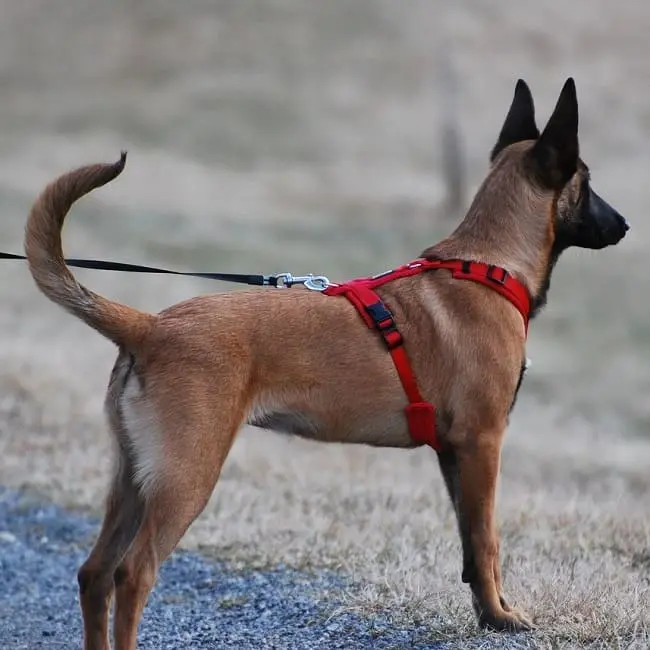Content
If you want to improve your dog’s comfort on walks, a harness can be an excellent idea. Unlike a conventional collar, which can be uncomfortable or even dangerous, exerting pressure on your pet’s neck, a harness distributes the force over the chest and back, avoiding any risk of injury.
A harness offers greater control over your dog, especially if he has a tendency to pull on the leash or react strongly to his environment. Whether it’s an anti-pull harness for training your dog, a sports harness for your shared activities, a car harness for safety on the move or a customized model, it’s essential to choose a harness adapted to your dog’s size, morphology and specific needs. Choose a quality harness that’s adjustable, breathable and equipped with reflective strips for optimum visibility.
This article will guide you step-by-step in the choice and use of a dog harness, enabling you to strengthen the bond with your companion while ensuring his safety and comfort.

Step 1: Choosing the right type of harness
Choosing the right harness for your dog depends on its intended use, size, morphology and behavior. There are several types of dog harness, each with its own advantages and disadvantages.
Here are the main types of dog harness and their specific features:
- Anti-pulling harness: Ideal for dogs that pull on the leash, this harness features a chest attachment that refocuses the dog on its owner when pulling. Recommended for hard-to-control dogs;
- Sport harness: Designed for activities such as canicross or skijoring, this harness features a back attachment that enables the dog to pull safely, while offering optimum freedom of movement;
- Car harness: Used to secure the dog in the car, it attaches to the seatbelt and protects the dog in the event of sudden braking. Its use is compulsory in some countries;
- Personalized harness: Personalize the look of your dog’s harness with the colors, patterns or text of your choice, with no specific functionality other than a touch of originality.
How to fit a dog harness properly?
A well-fitting harness is essential for comfort and efficiency. Follow these tips to choose and properly adjust your dog’s harness:
- Measure your dog’s chest and neck with a tape measure to determine the most suitable harness size. If in doubt between two sizes, choose the larger one;
- Try the harness on your dog before buying or ordering online, making sure it’s neither too tight nor too loose. You should be able to slip two fingers between the harness and your dog’s body;
- Adjust the harness according to its type. For an anti-pull harness, the chest clip should be centered and not interfere with the movement of the front legs. For a sports harness, it should not extend beyond the shoulder blades or compress the ribcage. For a car harness, make sure it’s securely fastened;
- Regularly check the condition and fit of the harness, which can become loose, deformed or damaged over time. If signs of wear or damage appear, replace or adjust the harness if necessary.
By following these recommendations, you’ll find the perfect harness for your dog, ensuring safer, more enjoyable outings for both of you.
Step 2: Preparing your dog
To get your dog used to his new harness, it’s essential to adopt a gentle approach, especially if the accessory is foreign to him. Gradual acclimatization and rewards play an essential role in this process.
Here are the steps to follow to familiarize your dog with the harness:
Getting your dog used to the harness
Start by introducing the harness in a playful way. Introduce it to your dog, let him explore it with his senses, sniffing, touching, even chewing, and offer him treats at every sign of interest. The aim is to create a positive association with the harness right from the start.
Gradually accustom your dog to wearing the harness for short periods, gradually increasing the duration. Praise him every time he wears it without protest. Associate the harness with activities he enjoys, such as playing, walking or eating, to reinforce this positive association.
The most important thing is that your dog perceives the harness as a positive element, not as a constraint.
Tips and tricks
The use of positive reinforcement is essential to encourage your dog to accept the harness. This means rewarding desirable behaviors, such as calmness, stillness and cooperation, and ignoring undesirable reactions, such as agitation or attempts to remove the harness.
Rewards can vary according to your dog’s preferences, from treats and petting to praise and toys. This method strengthens your bond, motivates your dog to learn and increases his confidence and well-being.
It’s imperative to avoid punishments such as yelling, tugging or hitting, which can have detrimental effects, generating fear, aggression or a loss of self-confidence.
By applying these tips, you’ll turn learning to wear a harness into a pleasant moment of complicity. You’ll quickly notice that your dog adapts to the harness and becomes easier to manage on outings.

Step 3: Putting on the harness
Once you’ve chosen the right harness for your dog and got him used to wearing it, it’s time to put it on properly and safely.
How to fit a dog with a harness?
The standard harness consists of two buckles, one for the neck and the other for the chest, connected by straps on the back and belly, and closes with fasteners or Velcro.
There are two ways to fit this type of harness to your dog: from below or from above.
The bottom method involves laying the harness flat, outer side down, and passing your dog’s front legs through the buckles. Then lift up the straps on his back and fasten them.
Although simple, this first method can be uncomfortable for your dog if the harness is too tight or if he doesn’t appreciate having his paws touched.
The top method involves pulling the harness over your dog’s head, taking care not to damage his ears. Then insert one paw into the corresponding buckle, follow with the other paw and close the harness by fastening the straps under the belly.
This second technique is quicker and more comfortable for the dog, but can be complicated if the harness is too small or the dog is restless.
How to adjust a harness for optimum safety?
A well-fitting harness is essential for your dog’s safety.
Make sure the harness is not too tight. You should be able to slip two fingers between the harness and your dog’s body. If necessary, loosen the straps or choose a larger size.
Make sure the harness is not too loose. It should fit snugly, without sagging or twisting. Tighten the straps or choose a smaller size if necessary.
Next, check the positioning of the harness. It should be centered on the dog’s back and chest, without rubbing or pulling. Adjust if necessary.
Finally, make sure the harness is properly fastened. Velcro fasteners should be firmly closed to prevent accidental opening or detachment.
Tips for specific adjustments according to dog breed or size
Harness fit can vary according to your dog’s breed and size. Here are some specific tips:
- For long-haired dogs, opt for a soft fabric harness to avoid knots and hair compression. Brush your dog’s coat before and after using the harness;
- For dogs with a broad chest, choose a Y-shaped harness for optimum comfort without obstructing breathing;
- For dogs with short necks, we recommend using a harness that slips on at the bottom to avoid chafing the neck;
- For dogs with sensitive skin, choose a harness made from soft materials such as cotton or fleece to avoid allergies and irritation.
By following these tips, you’ll ensure your dog’s maximum comfort and safety with his harness, making your outings safer and more enjoyable.
This article has guided you through the three simple but effective steps to fitting your dog with a harness. You’ve discovered how to choose the ideal harness, taking into account your dog’s intended use, size, morphology and behavior.
We’ve covered how to prepare your dog for wearing the harness, using positive reinforcement techniques and gradually getting him used to it. You’ve learned how to put the harness on your dog, whether from the bottom or the top, making sure it fits perfectly to guarantee his safety.
When you give your dog a harness, you’re giving him unrivalled comfort and safety. It avoids the risks of injury or strangulation often associated with collars, while improving control during walks. What’s more, it helps strengthen the bond between you and your companion, making the harness a positive element rather than a constraint.
- Discover also
- How to calm a barking dog?
